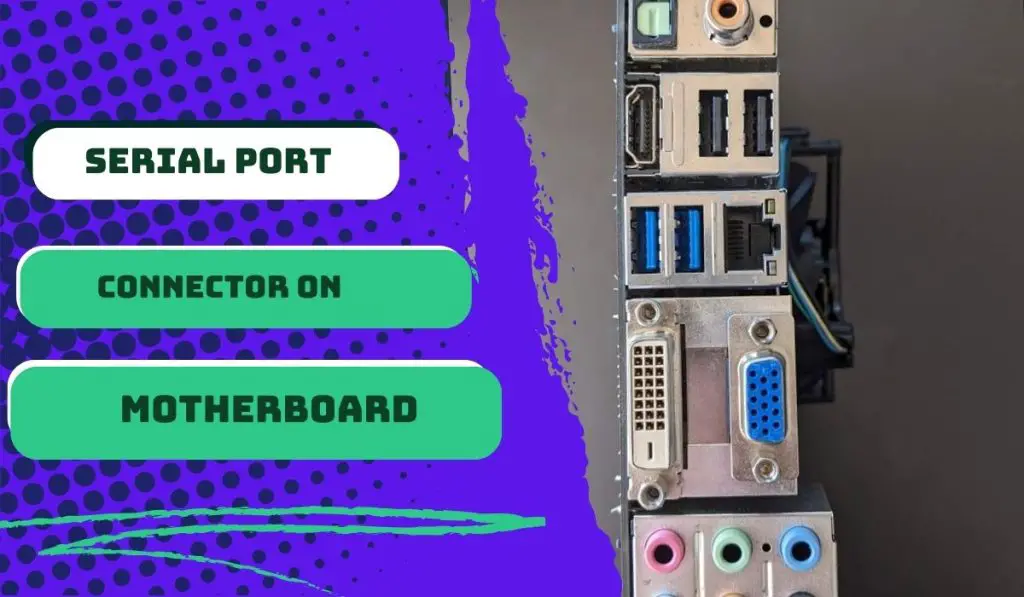The serial port connector is an interface that helps transmit incoming and outgoing information one bit at a time. It is also known as the COM port.
However, modern motherboards now feature USB ports that have higher transmission speeds, outshining the old technology of the serial port. Still, many industrial single-board computers ship with serial ports.
In the rest of this article, we will touch on how a serial port connector functions, serial port pin information, as well as the devices you can connect to a serial port if you have the interface on your motherboard.
What Is the Motherboard Serial Port Connector?
Serial ports were used in older motherboards and personal computers to transfer data from computers to various external devices such as modems and input devices like keyboards and mice. It is made up of 25 pins that transmit incoming and outgoing information, one bit at a time.
However, the COM1 port with the 9-pin version became common later on. But all the interface versions of serial ports are controlled by a Universal Asynchronous Receiver Transmitter chip, or UART.
On your motherboard, above the serial port, you will see the label “10101,” which is ones and zeros to represent binary. But in many cases, users take the “1” as the letter “I” and the zeros as the letter “O”, which explains why it’s sometimes referred to as the “IOIOI” port.
Serial Port Pin Information
Each pin on the DB9 serial port connector has a specific purpose and signal name. When you look at the interface on your system, mark the top-left portion of the port as pin one and count through to the bottom right as pin 9.
The serial name of the first pin on the serial port interface is “DCD.” The purpose of the pin is to detect the carrier, while the second pin is termed “RxData” as the signal name, and its purpose is to receive data.
The third and fourth pins on the serial interface have the purpose of transmitting data, and the data terminal is ready. Their signal names are TxData and DTR, respectively.
The fifth pin on the serial port connector is for signal ground (Gnd), while the sixth pin (DSR) is for data set ready.
Requests to send and clears to send are the purposes of the seventh (RTS) and eighth (CTS) pins on the COM port, respectively.
While the last pin is a ring indicator with the signal name “RI,”
If you get a modern motherboard today, you may not see the serial port (COM port) on the unit with the above 9 pins since most of today’s computers now use USB ports.
Do Motherboards Have Serial Ports?
Yes, motherboards do have serial ports. However, newer computers and laptops now ship with USB ports, FireWire, and other faster solutions, so you will hardly see serial ports.
However, if you do have an older version, you can check the back of the computer to locate the serial port.
What Devices Are Connected to The Serial Port?
The purpose of the serial port on computers was to transmit data from the computer to external devices. If your motherboard happens to have this COM port, here are various hardware components that you can purchase and use with the connector:
- Mouse: Back in the days of computers with no PS/2 or USB ports, the serial port connector served as a hub for connecting the mouse. Then, having a mouse was a luxury (or at least not as common as today).
- Printer: Old printers and plotters are examples of devices that connect to the serial port, but they also go into the parallel ports, and they need higher transmission speeds. But today, it is not a commonly used device for serial ports.
- Modem: The modem can also be connected to a serial port. But you will only have to use this with an older computer. Plus, it comes with ease of use. So why not?
- Network: Serial port connectors were integrated into older computers to allow for network connections, allowing two computers to connect to share large files.
Why Do Some Motherboards Still Have Serial Port Connectors Today?
Despite the availability of faster and more widely used alternatives, the traditional serial interface is still included in boards for several reasons.
- Firstly, there are still a multitude of devices that rely heavily on serial connectivity, such as many sensors that are currently shipped.
The simplicity of the serial interface from the device side is a major advantage, requiring only a UART and transceiver in most cases.
This ensures that serial sensor and data collection devices remain uncomplicated, affordable, and dependable.
As a result, even though it may seem outdated, the serial interface remains a crucial element in many industries.
- Another example of the practical application of the serial interface is its use in laser sensors for proximity and direction control in automated forklift equipment.
By connecting the sensor to the straightforward serial interface, the system can ensure safety by preventing accidents and injuries, all while maintaining a relatively fast and uncomplicated process.
- The fact that the serial interface is a dedicated interface is another reason why it hasn’t been entirely replaced by USB.
Setting up parameters for a USB-based device is required to ensure that the system recognizes it during boot-up, as it follows a plug-and-play approach as per the specification.
In contrast, the serial interface remains an established interface that does not require such extensive setup, making it a practical and straightforward option for many applications.
- Despite the rise of USB, the serial port remains a widely used and supported interface for connecting low-speed devices, suggesting that it may not be phased out anytime soon.
Meanwhile, the release of USB 2.0, with a transfer rate of 480 Mbits/s, marked a significant milestone for the USB interface.
Backward compatibility with the original standard made it a logical inclusion in most platforms moving forward, and the high volume of ports available allowed for the rapid and cost-effective production of supporting hardware, including interface ICs.
Consequently, while USB has become the dominant interface in many areas, the serial port remains a relevant and reliable choice for numerous applications.
Wrapping up
My first prebuilt HP unit did have a serial port connector, and I can recall using it to connect external devices (printers, testing equipment) that still needed serial ports.
If you have modern motherboards, you may never find this interface on the unit. But it’s not a bad idea to have a board with these because you never know when you’ll need one.
Meanwhile, most motherboards these days only have pin headers that allow you to connect an external port ribbon cable or expansion bracket. With this, you can then connect stuff, like automated monstrosities, digital scales in warehouses, and so on.
If we extend the conversation beyond the scope of motherboards, then serial port connectors are still very much in use to this day.
For example, GPS modules in ships, trains, and trucks still use serial interfaces for configuration, and other enterprise applications use serial ports too.




![How to Add More SATA Ports to Motherboard? [Guide] 5 How to Add More SATA Ports to Motherboard](https://bestofmotherboard.com/wp-content/uploads/2022/02/How-to-Add-More-SATA-Ports-to-Motherboard.jpg)
![How To Install Motherboard Drivers With USB? [Guide] 6 How To Install Motherboard Drivers With USB](https://bestofmotherboard.com/wp-content/uploads/2022/02/How-To-Install-Motherboard-Drivers-With-USB.jpg)